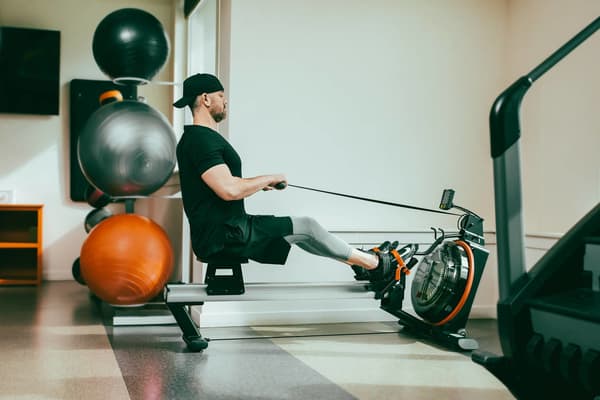5 Surprising Benefits of Walking Every Day, According to Experts
Sports & Activity
Going out for a daily stroll can have a positive impact on your health and overall wellbeing.

If you’re under the impression that going for a walk doesn’t count as a legitimate workout, think again.
“Many people overlook walking as a form of exercise because it seems too simple,” says Sharon Gam, Ph.D., C.S.C.S., ACE-HC, a certified personal trainer and health coach who has a doctorate in exercise physiology. “The truth is that walking might be the best type of exercise, and the fact that it’s simple makes it achievable for almost everyone.”
Since walking is low-impact and easy on the joints for most, she adds that it can be an ideal activity for those who are dealing with muscle or joint pain. And along with not requiring any special skills or training, it can effortlessly fit into your busy schedule, says Melina B. Jampolis, M.D., physician nutrition specialist and host of “Practically Healthy” by Dr. Melina podcast.
“Perhaps you can walk to your job, walk during your lunch break, hold a walking meeting with co-workers, walk your dog or walk with friends on a regular basis,” she says.
Don’t miss 8 Tips for Running With Your Dog!
How to Walk “Correctly”
In order to reap the most rewards from your walk, pay attention to your form, says Gam. “Walk by keeping your core muscles active with your chest and head up. Put your shoulders back and swing your arms in rhythm with your steps.”
As for the pace, try to make it brisk. “A leisurely stroll isn’t usually fast enough to stimulate the health benefits of walking, yet walking at a moderate pace will increase your heart rate,” she continues.
A few ways to determine a moderate pace include walking at least 100 steps per minute or — if you’re using a heart rate monitor — aiming for 65 percent to 75 percent of your maximum heart rate. “You can estimate your maximum heart rate by subtracting your age from 220,” says Gam. “For example, a 40-year-old would have a maximum heart rate of 180 beats per minute.”
Another method is the talk test. “At a moderate intensity, you should be able to talk in full sentences, but you’d be too out of breath to sing,” adds Gam.
Ultimately, both experts say that a beneficial walk can be measured by time or steps. “Time is the most clinically validated measurement, but total steps and distance can be a fun way to gauge your progress and challenge yourself,” says Jampolis.
The Centers for Disease Control and Prevention (CDC) recommends that adults get at least 150 minutes of moderate-intensity aerobic physical activity each week, which would equate to about five, 30-minute walks per week. If fitting 30 consecutive minutes into your day is a bit of a challenge, Gam suggests breaking up the walk into two 15-minute, or three 10-minute sessions throughout the day.
No matter how you get your 30 minutes in, it can provide a host of benefits, says Gam.
5 Potential Benefits of Walking
1.Walking Improves Heart Health
Regular walks may help prevent or manage cardiovascular disease, including heart disease, stroke, and high blood pressure, says Jampolis. A review published in the journal Cochrane Database of Systematic Reviews discovered “moderate-certainty evidence” that suggests walking may reduce systolic blood pressure. According to the American Heart Association (AHA), your systolic blood pressure is the top number of the measurement (for example, if 120/80 mmHg is your blood pressure, 120 represents systolic and 80 is diastolic) which indicates how much pressure your blood is exerting against your artery walls when your heart beats.
Also, a meta-analysis published in the Journal of Sport Health and Science found “significant associations” between step count and risk of all-cause mortality, as well as cardiac events. In fact, those who walked an average of 9,500 steps showed a decreased risk of all-cause mortality risk by nearly 35 percent and a lower risk of suffering from a cardiovascular event by almost 40 percent.
Yet when it comes to heart failure, a 27-year study from Denmark that involved more than 18,200 adults between the ages of 20 and 80 showed that speed, not duration, was linked to a decreased risk.
2.Walking Helps to Manage Blood Sugar Levels
Jampolis points to research that suggests walking may prevent or manage insulin resistance, prediabetes, gestational diabetes and type 2 diabetes. One large cohort study comprised of 197,825 non-diabetic adults found that fast walking was associated with lower rates of type 2 diabetes while a systematic review and meta-analysis published in the European Journal of Epidemiological studies suggest that women who walk before and during pregnancy may reduce their risk of gestational diabetes (diabetes during pregnancy). Furthermore, research published in The Journals of Gerontology indicates that short walks after prolonged sitting can have a positive effect on insulin levels.
“I like this particular study that shows the added benefits for blood sugar control with walking after meals, especially dinner since I recommend this to my patients with diabetes and prediabetes,” adds Jampolis.
3.Walking May Promote Better Sleep Quality
Walking during the day may lead to better sleep at night. After a four-week trial, researchers from Japan discovered that adults who didn’t exercise regularly but were instructed to walk 10,000 steps a day for 30 days reported falling asleep faster, sleeping longer and improved sleep quality (such as having restful sleep).
Another study gathered a group of healthy young adults between the ages of 19 and 36. Study participants were directed to walk one hour each day (at a rate of at least 60 steps per minute) on and off for a period of 12 weeks. The results, which were published in the Sport Sciences for Health, showed that daily outdoor walks were linked with improved sleep quality and duration, fewer sleep disturbances, and a reduced need for sleep medications.
So, why does all of this matter? Sleep is critical for your overall health. According to the National Institutes of Health (NIH), approximately 50 to 70 million U.S. adults suffer from sleep or wakefulness disorders, which have been associated with numerous health conditions, such as heart disease, high blood pressure, stroke, diabetes, and obesity, as well as certain cancers.
4.Walking Can Boost Your Mental Health
“Walking can also have powerful effects on the brain,” says Gam.
For starters, the low-impact exercise may help to reduce symptoms of depression. One study published in JAMA Psychiatry found that one hour of brisk walking could lower the risk of developing major depressive disorder (MDD) by 26 percent, as well as improve mood. Researchers from Iowa State University discovered that walking — whether indoors, outdoors, or on a treadmill can help bring about feelings of joy.
RELATED: How to Pick the Right Shoes for Treadmill Running
“[Walking] may also improve brain function, including memory, decision making, attention and even help you think faster and more creatively,” continues Gam. One study that focused on older adults who walked for exercise showed noticeable improvements in memory skills and white matter (the area of the brain that’s associated with aging and is composed of nerve fibers that help the cells send and receive messages).
5.Walking Reduces Risk of Certain Chronic Illnesses
Gam states that walking every day has been shown to lower risk factors that can lead to multiple diseases, including reducing the risk of neurological conditions — such as dementia and Parkinson’s disease — while increasing bone mineral density (which may prevent osteoporosis) and boosting immunity, according to a review published in Sports Medicine and Health Science.
“Walking can also help you live longer—and get the most of those extra years since they’re more likely to be healthy ones!”
Bottom Line
Even though walking may not sound like a “real” workout, studies indicate a number of possible health benefits that may come from taking a daily brisk walk. A few possible outcomes include warding off heart issues, keeping blood sugar levels under control, getting better sleep, experiencing fewer bouts of symptoms related to depression, and maybe even adding more candles to your birthday cake.
For more tips, be sure to download the Nike Training App!
Words by Amy Capetta
















